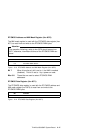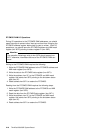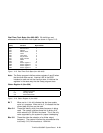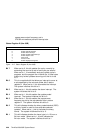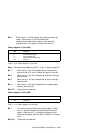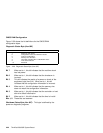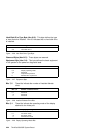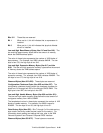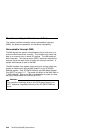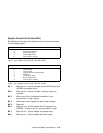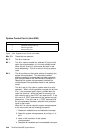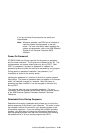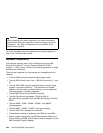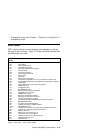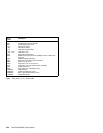Bits 3–2 These bits are reserved.
Bit 1 When set to 1, this bit indicates that a coprocessor is
installed.
Bit 0 When set to 1, this bit indicates that physical diskette
drive 0 is installed.
Low and High Base Memory Bytes (Hex 015 and Hex 016):
The
low and high base memory bytes define the amount of memory
below the 640KB address space.
The value in these bytes represents the number of 1KB blocks of
base memory. For example, hex 0280 indicates 640KB. The low
byte is hex 015; the high byte is hex 016.
Low and High Expansion Memory Bytes (Hex 017 and Hex
018):
The low and high expansion memory bytes define the amount
of memory above the 1MB address space.
The value in these bytes represents the number of 1KB blocks of
expansion memory. For example, hex 0800 indicates 2048KB. The
low byte is hex 017; the high byte is hex 018.
Reserved Bytes (Hex 01D–02D):
These bytes are reserved.
Configuration Checksum Bytes (Hex 02E and Hex 02F):
The
configuration checksum bytes contain the checksum character for
bytes hex 010 through hex 02D of the 64-byte CMOS RAM. The
high byte is hex 02E; the low byte is hex 02F.
Low and High Usable Memory Bytes (Hex 030 and Hex 031):
The low and high usable memory bytes define the total amount of
contiguous memory from 1MB to 20MB.
The hexadecimal values in these bytes represent the number of 1KB
blocks of usable memory. For example, hex 0800 is equal to
2048KB. The low byte is hex 30; the high byte is hex 31.
Date-Century Byte (Hex 032):
Bits 7 through 0 of the date-century
byte contain the binary-coded decimal value for the century. For
information about reading and setting this byte, refer to the
IBM
Personal System/2 and Personal Computer BIOS Interface
.
Reserved Bytes (Hex 033–07F):
These bytes are reserved.
ThinkPad 560/560E System Board 2-25



